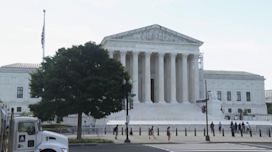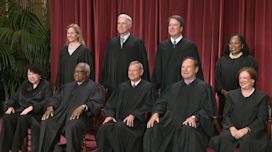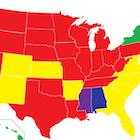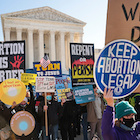Search results
5 days ago · Roe v. Wade was overturned by the Supreme Court in 2022. The case began in 1970 when “Jane Roe”—a fictional name used to protect the identity of the plaintiff, Norma McCorvey (1947–2017)—instituted federal action against Henry Wade, the district attorney of Dallas county, Texas, where Roe resided. The Supreme Court disagreed with Roe ...
- Norma McCorvey
Norma McCorvey (born September 22, 1947, Simmesport,...
- Right of Privacy
rights of privacy, in U.S. law, an amalgam of principles...
- Due Process
due process, a course of legal proceedings according to...
- Facts & Related Content
Roe v. Wade, legal case in which the U.S. Supreme Court on...
- Fourteenth Amendment
Fourteenth Amendment, amendment (1868) to the Constitution...
- U.S. Supreme Court
The organization of the federal judicial system, including...
- Norma McCorvey
- Abortion Before Roe v. Wade
- Jane Roe
- Henry Wade
- Supreme Court Ruling
- Legacy of Roe v. Wade
- Roe v. Wade Overturned
- Sources
Until the late 19th century, abortion was legal in the United States before “quickening,” the point at which a woman could first feel movements of the fetus, typically around the fourth month of pregnancy. Some of the early regulations related to abortion were enacted in the 1820s and 1830s and dealt with the sale of dangerous drugs that women used...
In 1969, Norma McCorvey, a Texaswoman in her early 20s, sought to terminate an unwanted pregnancy. McCorvey, who had grown up in difficult, impoverished circumstances, previously had given birth twice and given up both children for adoption. At the time of McCorvey’s pregnancy in 1969 abortion was legal in Texas—but only for the purpose of saving a...
In 1970, the attorneys filed a lawsuit on behalf of McCorvey and all the other women “who were or might become pregnant and want to consider all options,” against Henry Wade, the district attorney of Dallas County, where McCorvey lived. Earlier, in 1964, Wade was in the national spotlight when he prosecuted Jack Ruby, who killed Lee Harvey Oswald, ...
In June 1970, a Texas district court ruled that the state’s abortion ban was illegal because it violated a constitutional right to privacy. Afterward, Wade declared he’d continue to prosecute doctors who performed abortions. The case eventually was appealed to the U.S. Supreme Court. Meanwhile, McCovey gave birth and put the child up for adoption. ...
Norma McCorvey maintained a low profile following the court’s decision, but in the 1980s she was active in the abortion rights movement. However, in the mid-1990s, after becoming friends with the head of an anti-abortion group and converting to Catholicism, she turned into a vocal opponent of the procedure. Since Roe v. Wade, many states imposed re...
In 2022, the nation's highest court deliberated on Dobbs v. Jackson Women’s Health Organization, which regarded the constitutionality of a Mississippi law banning most abortions after 15 weeks of pregnancy. Lower courts had ruled the law was unconstitutional under Roe v. Wade. Under Roe, states had been prohibited from banning abortions before arou...
Abortion in American History. The Atlantic. High Court Rules Abortion Legal in First 3 Months. The New York Times. Norma McCorvey. The Washington Post. Sarah Weddington. Time. When Abortion Was a Crime, Leslie J. Reagan. University of California Press.
Videos - Roe v. Wade
2 years after Roe reversal, abortion becomes major campaign issue
CBS News Videos2 weeks agoMonday marks two years since the Supreme Court overturned Roe v. Wade. President Biden is campaigning on restoring abortion rights while former President Trump is touting his role in the reversal of the landmark case. Nancy Cordes has more.
Up Next
- 3:022 years after Roe reversal, abortion becomes major campaign issueCBS News VideosMonday marks two years since the Supreme Court overturned Roe v. Wade. President Biden is campaigning on restoring abortion rights while former President Trump is touting his role in the reversal of the landmark case. Nancy Cordes has more.2 weeks ago
- 1:21Where do legal challenges to abortion bans stand 2 years after Roe v. Wade was overturned?ABC News VideosThe U.S. Supreme Court has yet to issue a decision in a key case this year.2 weeks ago
- 2:31How a North Carolina abortion clinic has become a sanctuary for out-of-state patientsCBS News VideosTwo years ago, the U.S. Supreme Court overturned Roe v. Wade, ending the constitutional right to an abortion. CBS News got exclusive access to one clinic in North Carolina that has seen a stream of more out-of-state patients seeking care.2 weeks ago
- 4:51DNC chair talks reproductive rights on Dobbs decision anniversaryABC News VideosDNC Chair Jamie Harrison discusses voter concerns on the 2-year anniversary of Roe v. Wade being overturned.2 weeks ago
- 1:49Biden campaign marking Dobbs anniversaryABC News VideosOn the second anniversary of the Supreme Court decision overturning Roe v. Wade, The president is hoping to rally support for his campaign, promising to restore access to abortions if he's reelected.2 weeks ago
- 2:20Trump touts Dobbs decision in speech to evangelicalsCBS News VideosBefore a room of conservative Christians at a gathering of the Faith & Freedom Coalition in Washington, D.C., Saturday, former President Donald Trump Saturday touted the Supreme Court's decision two years ago to overturn Roe v. Wade as he seeks to shore up his support among evangelicals. Natalie Brand reports.2 weeks ago
- 1:28The state of abortion rights in the US two years after the Supreme Court overturned Roe v. WadeAssociated Press VideosJudges, state lawmakers and voters are deciding the future of abortion in the U.S. two years after the Supreme Court jolted the legal status quo with a ruling that overturned Roe v. Wade3 weeks ago
- 2:29Supreme Court preserves access to mifepristone in major abortion-related rulingCBS News VideosOn Thursday, the Supreme Court rejected restrictions on a widely used drug, mifepristone, used in abortion pills. It was the court's first major abortion-related ruling since it overturned Roe v. Wade two years ago. More decisions from the court are expected Friday.4 weeks ago
- 1:43Mifepristone may still be available, but opponents say the fight is not overAssociated Press VideosThe Supreme Court unanimously preserved access to a medication that was used in nearly two-thirds of all abortions in the U.S. last year, in the court’s first abortion decision since conservative justices overturned Roe v. Wade two years ago.4 weeks ago
- 4:08Trump touts role in overturning Roe v. Wade, Biden to meet with families of slain officersCBS News VideosFormer President Donald Trump was in Wisconsin and Michigan Wednesday where he hyped up his part in overturning Roe v. Wade and defended his policy of letting states make their own abortion laws. On the Democratic side, President Biden is heading to Charlotte, North Carolina, to meet with the families of the law enforcement officers killed in a shootout this week. CBS News senior White House and political correspondent Ed O'Keefe has more on the campaigns.2 months ago
Mar 17, 2023 · Roe v. Wade is a 1973 lawsuit that famously led to the Supreme Court making a ruling on abortion rights. Jane Roe, an unmarried pregnant woman, filed suit on behalf of herself and others to challenge Texas abortion laws. A Texas doctor joined Roe's lawsuit, arguing that the state's abortion laws were too vague for doctors to follow.
Summary. At a time when Texas law restricted abortions except to save the life of the mother, Jane Roe (a single, pregnant woman) sued Henry Wade, the local district attorney tasked with enforcing the abortion statute. She argued that the Texas law was unconstitutional.
Jan 22, 2012 · Roe v. Wade: A person may choose to have an abortion until a fetus becomes viable, based on the right to privacy contained in the Due Process Clause of the Fourteenth Amendment. Viability means the ability to live outside the womb, which usually happens between 24 and 28 weeks after conception.
In deciding for Roe, the U.S. Supreme Court invalidated all state laws that prohibited first-trimester abortions. Roe v. Wade stood as a precedent for nearly 50 years, but in 2022, the decision was overruled in Dobbs v. Jackson Women’s Health Organization. In Dobbs, the Court ruled that the Constitution does not protect the right to an abortion.
Roe v. Wade (1973) is a legal case in which the U.S. Supreme Court ruled that unduly restrictive state regulation of abortion is unconstitutional. The Court held that Texas statutes criminalizing abortion violated a constitutional right to privacy, which it found to be implicit in the due process clause of the Fourteenth Amendment. The Court ...























